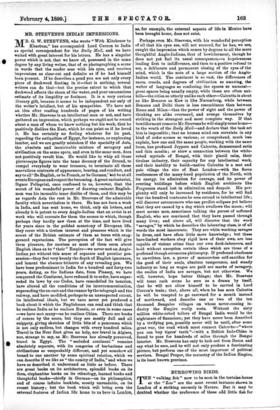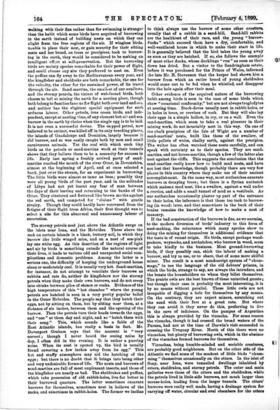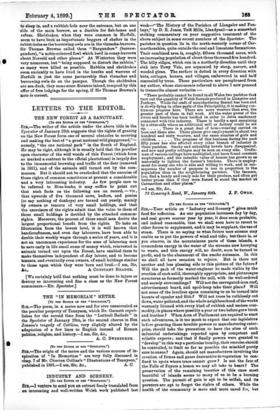BURROWING BIRDS.
THE" walking fish " now to be seen in the tortoise-house at the " Zoo" are the most recent instance shown in London of a striking anomaly in Nature. But it may he doubted whether the preference of these odd little fish for
walking with their fins rather than for swimming is stranger than the habit which some birds have acquired of burrowing in the earth instead of building nests on which they can alight from the free regions of the air. If wingless birds, unable to place their nest, or gain security for their sitting mate and her brood, on trees or precipices, took to burrow- ing in the earth, they would be considered to be making an intelligent effort at self-preservation. But the burrowing birds are mainly species remarkable for their power of flight, and could choose any site they preferred to nest on. Even the puffins can fly away to the Mediterranean every year, and the kingfisher and sheldrake are both remarkable, the one for the velocity, the other for the sustained power, of its travel through the air. Sand-martins, the smallest of our swallows, and the stormy petrels, the tiniest of web-footed birds, both choose to toil at mining the earth for a nesting place, though both belong to families famcus for flight both over land and kea. and neither has the slightest special equipment for such arduous labour. Other petrels, true ocean birds, and inde- pendent, except at nesting time, of any element but air and sea, burrow in the earth by choice when the single egg is to be laid. It is not even a snccessf al device. The ca pped petrel, now believed to be extinct, was killed off in its only breeding places, the islands of Guadeloupe and Dominica, largely because it did burrow, and so was easily caught both by men and small carnivorous animals. Yet the zeal with which such tiny birds as the petrels or sand-martins work at their tunnels shows that they believe them to be a necessity for success in life. Early last spring a freshly arrived party of sand- martins reached the mouth of the river Otter, in Devonshire, almost at the beginning of April, and at once selected a bank, just over the stream, for an experiment in burrowing. The little birds were almost as tame as bees ; possibly they were all young birds of the past year, and in the solitudes of Libya had not yet learnt any fear of man between the days of their leaving and returning to the banks of the Otter. They clustered and flattered like brown moths against the red earth, and competed for 'claims " with gentle rivalry. Though they could hardly have recovered from the futigue of their flight trom Africa, their first thought was to select a site for this abnormal and unnecessary labour of excavation.
The stormy petrels nest just above the Atlantic surge on the islets near Iona, and the Hebrides. There above the rock on certain islands is a black, buttery soil, in which they burrow like little winged mice, and on a nest of sea-pink lay one white egg. As this desertion of the regions of light and air by birds is something outside the natural course of their lives, it leads to various odd and unexpected social com- plications and domestic problems. Among the latter is a serious one, the difficulty of keeping the underground house clean or moderately cool. It is usually very hot. Sand-martins, for instance, do not attempt to ventilate their burrows as rabbits and rats do, neither do kingfishers nor the stormy petrels when they make their own burrows, and do not creep into chinks between piles of stones or rocks. Evidence of the high temperature of this " hot chamber " where the young petrels are hatched is seen in a very pretty popular belief in the Outer Hebrides. The people say that they hatch their eggs, not by sitting on them, but by sitting near them, at a distance of six inches, between them and the opening of the barrow. Then the petrels turn their heads towards the eggs, and "coo" at them day and night, and so "hatch them with their song." This, which sounds like a fable of the East Atlantic islands, has really a basis in fact. Mr, Davenport Graham says that the account is " very correct ; though I never heard the cooing noise by dey, I often did in the evening. It is rather a purring noise. When its nest is opened up, the bird is usually found cowering a few inches away from its egg." This hot and stuffy atmosphere may aid the hatching of the eggs ; but there is no doubt that it brings into being other and very undesirable forms of life. The nests and burrows of sand-martins are full of most unpleasant insects, and those of the kingfisher are nearly as bad. The sheldrakes and puffins, which take possession of old rabbit-holes, live far better in their burrowed quarters. The latter sometimes excavate burrows for themselves, sometimes nest in hollows of the rocks, and sometimes in rabbit-holes. The former we incline to think always use the burrow of some other creature, usually that of a rabbit in a sand-hilL Sand-hill rabbits are the healthiest of their race, and the young " burrow- ducks " which succeed them have a dry, comfortable, and well-ventilated house in which to make their start in life. It is generally believed that the bird takes the young away as soon as they are hatched. If so, she follows the example of most other ducks, whose ducklings " ran" as soon as their down has dried. But a visitor to the Sandringham estate, before it was purchased for the Prince of Wales, informed :he late Mr. H. Stevenson that the keeper had shown him a burrow from which an entire brood of young sheldrakes would come out to be fed when he whistled, and disappear into the hole again after their meal.
Other evidence of the acquired nature of the burrowing habit among birds is seen in the case of some birds which show "occasional conformity," but are not always troglodytes at nesting time. Stock-doves usually nest in rabbit-holes, or in holes in trees, or crevices of rock. But they will also lay their eggs in a simple hollow, in ivy, or on a wall. Even the sand-martins, which seem to take a real pleasure in their mining work, do not invariably nest in this way. On one of the chalk precipices of the Isle of Wight are a number of sand-martins' nests, built like those of the swallow, of little pellets of white, chalky earth, against the precipice. The writer has often watched these nests carefully, and can speak with certainty as to their species. They are sand. martins, and not house-martins, though a few of the latter also nest against the cliffs. This suggests the conclusion that the sand-martins really know how to build mud nests, and have not lost that knowledge, though probably there are very few pieces in this country where they make use of their ancient accomplishment. In the same way, most nuthatches excavate burrows in decaying trees ; but there is a Syrian nuthatch which makes a mud nest, like a swallow, against a wall under a crevice, and adds a small tunnel of mud as a vestibule. As our nuthatches occasionally plaster up part of the entrance to their holes, the inference is that these too took to burrow- ing (in wood) Jater, and that somewhere in the back of their brains remains the knowledge of how to make a nest of masonry.
If the bad construction of the barrows is due, as we surmise, to the modern diversion of birds' industry to this form of nest-making, the reluctance which many species show to doing the mining for themselves is additional evidence that the taste is of recent origin. No birds, except perhaps wood- peckers, wrynecks, and nuthatches, who barrow in wood, seem to take kindly to the business. Most ground-burrowing birds, if they possibly can, shirk the labour of making a burrow, and try to use, or-to share, that of some more skilful miner. The result is a most nondescript system of " chum. mage," to use the language of the old debtors' prisons, in which the birds, strange to say, are always the intruders, and the beasts the householders on whom they billet themselves. The prairie owls are the best known of these uninvited guests ; but though their case is probably the most interesting, it is by no means without parallel. These little owls are not incapable of digging a hole for themselves by any means. On the contrary, they are expert miners, scratching out the sand with their feet at a great rate. But where they can avoid it they never do this, preferring to live in the cave of indolence. On the pampas of Argentina this is always provided by the vizcacha. For some reason the vizcacha, though it had crossed the broad waters of the Parana, had not at the time of Darwin's visit succeeded in crossing the Uruguay River. North of this there were no vizcachas, but plenty of burrowing owls, which in the absence of the vizcachas formed burrows for themselves.
Vizcachas, being humble-minded and sociable creatures, are probably good neighbours. But on the other side of the Atlantic we find some of the meekest of little birds "chum- ming " themselves occasionally on the otters. In the islet of Softy, near Iona, were tunnelled dwellings inhabited- by otters, sheldrakes, and stormy petrels. The outer and main galleries were those of the otters and the sheldrakes, while the petrels lived in little side burrows, not much larger than mouse-holes, leading from the larger tunnels. The otters' burrows were really well made, having a drainage system for carrying off water, circular and oval chambers for the otters
to sleep in, and a rubbish-hole near the entrance, but on one side of the main burrow, as a dustbin for fish-bones and refuse. Sheldrakes, when they were common in Norfolk, seem to have-been as importunate beggars of shelter in the rabbit-boles as the burrowing owls are in the vizcacha-burrows. Sir Thomas Browne called them " Bargnnders" (burrow- gunders), "a noble-coloured fowl which herd in coney-burrows about Norrold and other places." At Winterton they were very numerous, but " being supposed to disturb the rabbits," as many were killed as possible. Rabbits and sheldrakcs seem anciently to have lived in the heaths and warrens of Norfolk in just the same partnership that vizcachas and burrowing owls do on the pampas. Though the sheldrakes are sea-duck, they came some distance inland, tempted by this offer of free lodgings for the spring, if Sir Thomas Browne's note is correct.




































 Previous page
Previous page